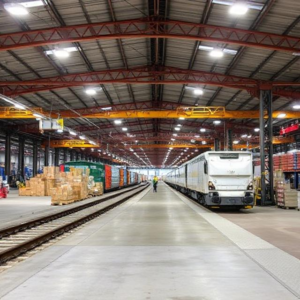1. Challenges in Integrating Indian Railways with Other Modes of Transport
Integrating Indian Railways with other modes of transport, like buses, metros, airports, and seaports, is important for making travel easier and more efficient. But there are several challenges to making this happen:

a) Coordination Between Different Agencies
- Indian Railways is run by the government, but other transport systems (like buses, metros, and airports) are often managed by different agencies. Getting all these organizations to work together smoothly can be difficult.
b) Lack of Proper Infrastructure
- Many stations and transport hubs are old and may not be designed to handle multiple modes of transport at once. For example, a train station might not have space for buses to park nearby, or a metro station may not be directly connected to railway tracks.
c) Timing and Scheduling Issues
- Trains, buses, and metro services may have different schedules. If there’s no coordination in their timings, it can be frustrating for passengers who need to transfer from one mode to another.
d) Ticketing and Payment Systems
- Each transport system often uses its own ticketing system. Passengers may need to buy separate tickets for the train, metro, and bus, which can be inconvenient. Having a common system where people can use one ticket for multiple modes of transport is a challenge.
e) Space and Connectivity
- In some cities, transport systems like metros or buses may not be connected well to railway stations. If a metro station or bus stop is far away from the train station, it becomes hard for passengers to transfer from one mode to another.
2. Efforts to Create Multimodal Transport Solutions (e.g., Train, Bus, Metro)
Despite these challenges, India is working on creating multimodal transport solutions, where different forms of transport (trains, buses, metros, etc.) are well-connected. Here are some efforts being made:
a) Integrated Transport Hubs
- New transport hubs are being developed where different modes of transport come together. For example, at a central station, you could find a train, metro, and bus services all in one place, making it easy to switch between them.
b) Coordinating Schedules
- Efforts are being made to align the schedules of different transport modes. For example, metro trains and buses may be scheduled to arrive and depart in a way that makes it easier for passengers to transfer between them.
c) Unified Ticketing System
- To make travel easier, there are efforts to create a single ticket system that allows passengers to travel by train, bus, and metro with just one ticket. This would reduce the hassle of buying separate tickets for each mode of transport.
d) Smart Transportation Solutions
- Cities are adopting smart technologies to improve connectivity between different transport systems. Apps and digital platforms are being used to provide real-time information about trains, buses, and metro services, helping passengers plan their journey more efficiently.
3. Integration of Rail Services with Airports, Seaports, and Road Transport
Integrating railways with airports, seaports, and road transport is important for both passengers and goods.
a) Rail-Airport Connectivity
- Many airports are now being connected directly to railway stations. For example, in cities like Delhi and Mumbai, express trains connect the city to the airport. This helps passengers travel quickly and efficiently between the airport and the city center.
b) Rail-Seaport Connectivity
- Connecting seaports with railways helps transport goods more easily. For example, cargo trains can move goods directly from a port to inland areas, speeding up the delivery process.
c) Rail-Road Transport Integration
- Integrating rail with road transport helps both passengers and goods move efficiently. For example, buses or taxis may pick up passengers from a train station and take them to their final destination. Similarly, cargo trucks can transport goods to and from rail yards, making it easier to move products over long distances.
4. Benefits of Seamless Connectivity for Passengers and Freight
When train services are well-integrated with other modes of transport, it brings many benefits:
a) For Passengers:
- Convenience: Passengers can travel easily from one mode of transport to another, without worrying about timing or ticketing issues.
- Time-Saving: When everything is connected, passengers don’t need to wait for long periods between transferring from one mode of transport to another. This makes travel faster.
- Cost-Effective: With a unified ticketing system, passengers can save money as they won’t need to buy separate tickets for each mode of transport.
- Better Accessibility: Travelers, especially those with disabilities, can easily use connected transport systems that are designed to be more accessible, such as elevators and ramps.
b) For Freight (Goods Transport):
- Faster Deliveries: With trains, trucks, and ships all connected, goods can move more quickly from one place to another, cutting down delivery times.
- Lower Costs: Transporting goods by train, truck, and ship together can reduce costs, as rail is cheaper for long-distance travel compared to road transport.
- Increased Efficiency: A smooth flow of goods between different transport systems increases the overall efficiency of logistics and reduces delays.
Conclusion:
Integrating Indian Railways with other transport systems like buses, metros, airports, and seaports faces challenges like coordination between agencies, infrastructure, and ticketing issues. However, efforts are being made to improve this integration through better transport hubs, unified ticketing systems, and smarter technologies. Seamless connectivity between trains and other transport modes brings great benefits, making travel easier and faster for passengers, and improving the efficiency of freight movement. This leads to smoother and more affordable travel, benefiting both individuals and businesses.
Keywords: Indian Railway, Railway











